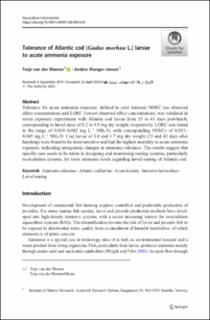| dc.contributor.author | van der Meeren, Terje | |
| dc.contributor.author | Mangor-Jensen, Anders | |
| dc.date.accessioned | 2020-10-27T12:53:16Z | |
| dc.date.available | 2020-10-27T12:53:16Z | |
| dc.date.created | 2020-05-08T11:10:40Z | |
| dc.date.issued | 2020 | |
| dc.identifier.citation | Aquaculture International. 2020, . | en_US |
| dc.identifier.issn | 0967-6120 | |
| dc.identifier.uri | https://hdl.handle.net/11250/2685280 | |
| dc.description.abstract | Tolerance for acute ammonia exposure, defined to exist between NOEC (no observed effect concentration) and LOEC (lowest observed effect concentration), was validated in seven exposure experiments with Atlantic cod larvae from 15 to 63 days post-hatch, corresponding to larval sizes of 0.2 to 4.9 mg dry weight, respectively. LOEC was found in the range of 0.019–0.082 mg L−1 NH3-N, with corresponding NOECs of 0.013–0.045 mg L−1 NH3-N. Cod larvae of 1.0 and 1.7 mg dry weight (33 and 42 days after hatching) were found to be most sensitive and had the highest mortality to acute ammonia exposure, indicating ontogenetic changes in ammonia tolerance. The results suggest that specific care needs to be taken in designing and monitoring rearing systems, particularly recirculation systems, for toxic ammonia levels regarding larval rearing of Atlantic cod. | en_US |
| dc.language.iso | eng | en_US |
| dc.title | Tolerance of Atlantic cod (Gadus morhua L.) larvae to acute ammonia exposure. | en_US |
| dc.type | Peer reviewed | en_US |
| dc.type | Journal article | en_US |
| dc.description.version | publishedVersion | en_US |
| dc.source.pagenumber | 17 | en_US |
| dc.source.journal | Aquaculture International | en_US |
| dc.identifier.doi | https://doi.org/10.1007/s10499-020-00555-8 | |
| dc.identifier.cristin | 1809916 | |
| cristin.ispublished | true | |
| cristin.fulltext | original | |
| cristin.qualitycode | 1 | |
